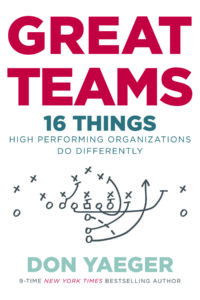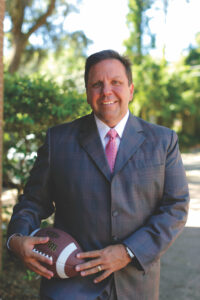What Great Teams Do Differently
Don Yaeger is an expert on what it takes to cultivate a champion mindset. He was associate editor of Sports Illustrated for over a decade; he has made guest appearances on every show from Oprah to Good Morning America, and he’s also authored more than two dozen books. Now a public speaker, he shares stories from the greatest winners of our generation.
So when his new book, Great Teams: 16 Things High Performing Organizations Do Differently, arrived on my desk, I couldn’t wait to read it.
I wasn’t disappointed. Don’s insight on high-performance is evident on every single page. I recently had the opportunity to talk with him about his research into what makes a team great.
Use Your Why to Motivate
Don, you’ve seen the inside of great teams in the sports and the business worlds. Your new book focuses on 16 characteristics of great teams. Let’s talk about a few of them.
Your first point is that great teams understand their why. Purpose motivates both individuals and teams. How does the personal “why” interact with the team “why”? Do they ever conflict?
In the business world, a “why” is often misunderstood as a company mission statement or code of ethics—which couldn’t be further from the truth. Author and motivational speaker Simon Sinek has described a company’s corporate “why” as “always disconnected from the product, service, or the act you’re performing.” If an organization desires to become a Great Team in the business world, then it must understand how to utilize the “why” properly in order to galvanize support from its professional ranks. “When an organization lays out its cause, how it does so matters,” explained Sinek. “It’s not an argument to be made, but a context to be provided. An organization’s ‘why’ literally has to come first—before anything else.”
Companies that understand the purpose and philosophy behind the “why” are usually astute, high-performing organizations that tap directly into the pulse of those they benefit the most. When utilized correctly, this understanding can create a powerful sense of duty and purpose for business teams because the employees know exactly whom they are working for and to what end.
Let Culture Shape Recruiting
You talk about letting culture shape recruiting. In a large company, how do you make this a reality so that every single hiring manager is thinking about culture and not just reviewing a resume?
Purpose and leadership are essential to building a team culture. Once an organization determines its “why” and aligns its leadership style with the needs of its members, it is on the right path to becoming a Great Team. But culture building doesn’t stop there. A team must also recruit the right talent. If done well, recruiting will result in a highly competitive team that is consistently motivated to seek and claim success.
Great Teams recruit players who fit—who will thrive within the established team culture and add value to it. The talent of the employee or teammate is important, but fit trumps all. These organizations understand that Great Team culture establishes an environment conducive to success, but that success ultimately depends on the right kind of personnel.
In today’s marketplace, it is very easy to be wowed by decorated resumes. When the “ideal” candidate—the one with the outstanding CV—arrives, many leaders incorrectly believe that including that person will automatically better the team. A Great Team, however, understands that fit is more important than credentials. Someone who might be perfect for one environment—or might have been great while working for a competitor—will not be a guaranteed fit for another. That’s something hiring managers should keep in mind as they build their teams.
Successful Huddles Are Crucial
What makes a successful huddle?
Successful huddles are all about open and consistent communication. Under head coach Bill Walsh, the San Francisco 49ers placed such importance on the art of the meeting that he had specific rules and procedures regarding how each one should run. Walsh analyzed and even recorded meetings to spot potential lulls and weaknesses in their process. He wanted to make sure his assistant coaches—who would sometimes change from year to year—were teaching his team in a consistent fashion.
Quarterback Joe Montana, who came on board right after Walsh did, shared Walsh’s high opinion of meetings. This legendary team leader—who won four Super Bowl championships and is tied for the most titles among all quarterbacks—was known in and around the NFL as “Joe Cool.” He had an uncanny knack for seeing all aspects of the game from his position on the field and was seemingly unflappable in the most pressurized situations. And there was a reason for Montana’s demeanor: like Walsh, he believed in a very diligent, orderly meeting process as a means of keeping players engaged. For Montana, the huddle was a sacred place and the ultimate comfort zone. There were rules to be followed when Montana was giving out information for the next play. If those rules weren’t adhered to, Montana told his teammates to take the issue somewhere else. The huddle was a place where everyone needed to be engaged and headed in the same direction.
Great Teams in businesses can take a page from Walsh’s and Montana’s playbook and conduct orderly, disciplined meetings. Such order makes a bigger difference than many leaders want to admit. A successful meeting revolves around clear communication. It can be pivotal to achieving greatness because it explains precise strategy and opens the door to new ideas. An efficient meeting allows an organization to remain one step ahead of the competition and forces it to remain consistent with any existing strategies. But these ideas must be streamlined by a process and guided by a leader who can filter out the good ideas from the bad.
16 Things High-Performing Organizations Do Differently
- Great teams understand their why.
- Great teams have and develop great leaders.
- Great teams allow culture to shape recruiting.
- Great teams create and maintain depth.
- Great teams have a road map.
- Great teams promote camaraderie and a sense of collective direction.
- Great teams manage dysfunction, friction, and strong personalities.
- Great teams build a mentoring culture.
- Great teams adjust quickly to leadership transitions.
- Great teams adapt and embrace change.
- Great teams run successful huddles.
- Great teams improve through scouting.
- Great teams see value others miss.
- Great teams win in critical situations.
- Great teams speak a different language.
- Great teams avoid the pitfalls of success.
Would you share an example of where one team missed “value” and another team spotted it and capitalized on it?
Great Teams never answer the “why” question with “because we’ve always done it this way.” Instead, they regularly evaluate each situation and seek unique opportunities for improvement.
 One Great Team that had a knack for finding the value in players that other teams passed on was the Detroit Pistons. In 2003 the Pistons began a six-season run of success. Every season, they at least reached the NBA Eastern Conference championship. They made the finals twice and captured an NBA championship in 2004. The streak was even more impressive in light of the fact that the Pistons roster consisted of league castoffs. Four of Detroit’s five starting players had been acquired either in free agency or trade.
One Great Team that had a knack for finding the value in players that other teams passed on was the Detroit Pistons. In 2003 the Pistons began a six-season run of success. Every season, they at least reached the NBA Eastern Conference championship. They made the finals twice and captured an NBA championship in 2004. The streak was even more impressive in light of the fact that the Pistons roster consisted of league castoffs. Four of Detroit’s five starting players had been acquired either in free agency or trade.
This motley crew included guards Chauncey Billups and Richard Hamilton, the short-tempered Rasheed Wallace—who led the NBA in technical fouls—and defensive and rebounding champ Ben Wallace, who possessed little offensive talent. While considered good by most NBA analysts, each player had defects in his individual game. Only once in that six-year run did any player—Richard Hamilton—even average twenty points per game over a whole season.
And yet the value of the Pistons as a whole was more than the sum of its individual parts. Together the players formed a machine of consistency, a cohesive unit that played impeccable defense and fed off each other on offense.
General manager Joe Dumars, who had played on Detroit’s previous title-winning teams in the 1990s with Isiah Thomas, was among the first in the league to recognize how a cohesive unit could be built with players rejected by other teams. But Dumars also knew he had to be careful with spending money; the Pistons couldn’t simply go out and buy the best available players in free agency. So Dumars set out to build his team culture by finding available talent at low cost and, he hoped, finding players with chips on their shoulders.
This strategy made all the difference in a league full of free-agent-riddled teams with pricey contracts and zero chemistry. The Pistons developed a team based on the resources available and found success. With his ragtag team of players, Dumars seized upon the hurt pride and desire of the Pistons and created NBA champions.
Are you READY to take your team to the next level? By signing up for FREE to Leadership Insights, you will be on your way![/subscribe]
Speak Success into Existence
I love your chapter on speaking success into existence. Talk about the power of words. How does a leader’s words shape the culture and the team?
Through success or failure, great leaders always know what to say to bring out the best in their organizations. Many teams undervalue the art of properly framing communication, especially in times of struggle. Successful leaders do not berate or chide team members but seek ways to positively articulate objectives and expectations. They have better coaching conversations, ask better questions, and drive results. Positive communication is not only a habit for high- performance teams but also a tool used to reinforce and enhance the values of organizations.
Communication that inspires, motivates, and encourages is one of the most important steps in achieving greatness. Through the good and bad, articulating praise and criticism in positive ways is essential to the success of the team. When you speak the language of a Great Team, you communicate constructive feedback that penetrates even the most unwilling ears—and keeps people motivated long after the feedback has been received. That language includes leading by example, asking the right questions, using effective praise, and affirming character.
As you compiled your list, reflected on your experiences, and researched great teams, what was most surprising to you?
As I started this book, my initial definition of a Great Team was one that won championships. But I discovered it was more important for a Great Team to be consistently relevant. Think about the best teams in sports. The St. Louis Cardinals, the New England Patriots, the Pittsburgh Steelers, and the San Antonio Spurs are in the playoff hunt and contending for the championship almost every single season. Studying the teams that are always in the conversation of success offers far better examples of greatness than just looking at teams that win trophies.
The Power of One
Would you share an example where one person, added to the team, changed the course of the organization?
David Ross comes to mind. After a disastrous season under Bobby Valentine in 2012, their worst in almost fifty years and their first time in the cellar in twenty years, the Boston Red Sox targeted David Ross, a journeyman catcher who spent most of his career as a backup, in free agency. Ross became the first free agent they signed and plenty of people were wondering what the Red Sox were thinking.
However, David Ross was more than just a backup catcher. He is the personification of what it means to be a great teammate, the guy everyone wants to work with. Teammates like Ross make everyone on their team better. They bring out the best in people by sharing their knowledge, offering their support and always putting the team’s goals ahead of their own.
Ross’ attitude, which was contagious, was far more important to the Red Sox than what he did on the field. By being a great teammate, Ross helped heal a fractured locker room and played a major role in the Red Sox going from worst to first in 2013—and winning the World Series to boot.
Great Teams: 16 Things High Performing Organizations Do Differently

